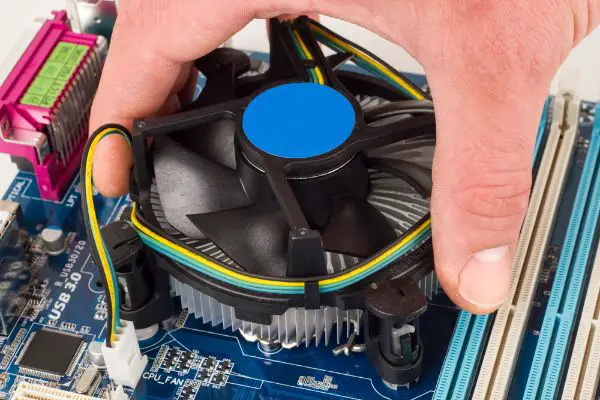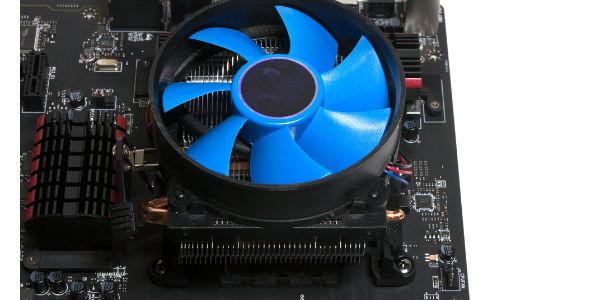Disclaimer: This post may contain affiliate links, meaning we get a small commission if you make a purchase through our links, at no cost to you. For more information, please visit our Disclaimer Page.
Your computer’s central processor is the brain that helps all of the system processes run smoothly. Data from the hard drive transfers to the unit’s random-access memory, and the CPU uses this information to run programs, follow instructions that the operating system provides for it, and more.
As one of the main components inside a computer, the central processor does a lot of the grunt work that you don’t see happening inside the tower or case. As it works hard for you, it uses energy and builds up heat. Should the heat levels here get too high, the computer could start posting errors, behaving erratically, or shut itself down as a protective measure. To avoid all of this, parts like the CPU come with coolers to siphon off the heat.
Coolers need to be fairly tight within the frame of the computer for stability, but some users have concerns that they might tighten their units too much. We can discuss the possible things that might happen if you do this, and our topics will include potential damage to the computer’s motherboard, another important part of the system.
As we go along, we will try to give some helpful guidelines as to how much you should tighten your cooler in an ideal scenario. We’ll also think of some reasons why you might be having difficulties in tightening your cooler into place at all.
Table of Contents
Can a CPU Cooler Be Too Tight?
In short, it is possible for a central processor cooling unit to be too tight. In most cases, you should not have this issue with computers that you get off the shelf that the manufacturer has put together.
While mistakes do happen, companies that make these computers have vast experience in putting them together and getting them ready for consumers.
The bigger risk comes when you are upgrading or building a system by yourself. Even with some know-how, it is possible that you’ll tighten your cooler for the CPU a bit too much.
What Happens if You Tighten a CPU Cooler Too Much?
There are a few risks involved when you tighten the central processor cooler to a degree that is too severe for it to handle. For the most part, this process is one that will have consequences for other components near the cooler, but the CPU cooler itself can take some damage, too. One of the most obvious issues you might face is stripping the heads of screws that you turn too tightly.
Although this may not damage the cooler or surrounding hardware, it does make it much more difficult to remove the screws later. This could make it hard for you to upgrade either the central processor or cooling unit itself later. You also need to remove some parts in order to get to others, and screws that don’t have working heads can make everything more difficult for you.
Another issue you may face deals with thermal paste. This paste is just a title that many tech users give to the compound that helps the sink transfer excess heat away from the hot central processor.
You may hear some people refer to by titles like gel, grease, fluid, or thermal interface material. This paste serves to eliminate possible gaps that keep heat from dissipating between the cooler and the processor.
If your CPU’s cooler is on too tightly, it may squeeze some of the paste out of alignment. Should this happen, it becomes less likely that the material can deal with heat transfers effectively. In turn, this leaves your processor more prone to overheating.
Furthermore, tightening the screws too much can place undue pressure on the central processor itself. If this happens, you run the risk of cracking the CPU physically.
This sort of damage could break the processor, or it might behave very erratically before dying on you altogether. Even if your computer seems to be doing fine with a cracked or damaged central processor, you should take steps to replace it as soon as you can.
As we touched on earlier, this is one of the most important parts of your system, and it should not suffer any physical damage. If it does, the risk of the whole system failing when you need it most is quite high.
Can a CPU Cooler Damage a Motherboard?
Besides damaging the central processor, tightening the screws on the CPU cooler too much can hurt the motherboard, too.
Just like the CPU, your computer’s motherboard is one of its most crucial components. It is the main circuit board for the system, and it helps all the other hardware inside your computer send messages back and forth.
It has many delicate circuits, and a CPU cooler that you tighten too much can place a lot of pressure on these circuits. If things are too tight, you run the risk of the cooler stressing out the board. If this happens, it could crack the motherboard.
On a related note, some of the main circuits printed on the board get quite dense around the socket for the central processor. This means many important circuits could take terrible damage at once.
Should this happen, your motherboard could be unable to send the proper signals to the rest of the hardware. Your computer might be prone to far more instability, programs not running properly, a sluggish operating system, or trouble booting up at all.
This whole problem is not as likely to occur if the computer remains stationary for years. However, the risks might increase if you expect to move the tower case, either once in a while or regularly. This is because physically moving the case can jostle the parts.
While it may seem as though a very tight CPU cooler can be a good thing here, it also means that you place more strain on the motherboard when such a cooler is against it.
This is particularly true if you favor a large, heavy cooler. Although the mounting bracket should distribute the weight of such a cooler, one that is in transit inside the case is another story.
How Much Should You Tighten a CPU Cooler?
Before we dive into just how much is enough when it comes to installing a central processor cooler, we’ll stress that how much you tighten it can vary based on the make and model.
Different coolers sporting various dimensions may need more or less tightening than we might recommend here. That said, we will try to provide some general guidelines that can help you with many kinds of coolers on the market today.
It is a good idea to start with tightening the screws as much as possible with your hands first. This method can give you a good indication of how tight each screw is, and it minimizes the possibility of you tightening any of them too much. Once you’ve done this with your hands, you may wish to top it off with a bit more tightening from the appropriate size of screwdriver.
You don’t need to torque it down hard, but you can give it a few more turns. When a screw does not seem to tighten smoothly with just a bit of pressure from you, it is probably tight enough to suffice. As an added step, you can check how flush the cooler is against its plate or bracket.
The cooler should rest flat against the processor itself, but it should do so without squeezing out thermal paste. If things look good to you, your computer is probably good to go.
Why Can’t I Screw in My CPU Cooler? (Solved!)
In some cases, you may find that it seems to be impossible to screw in your new CPU cooler. In one set of circumstances, you may be unable to get the screws to go in at all. Otherwise, you might also have a problem with getting the cooler screwed down tightly enough to make it secure. For the most part, this problem relates to the backplate that helps to mount your CPU cooler to its proper place.
Your motherboard comes with a backplate that allows you to add components like the CPU cooler. If you cannot seem to screw the cooler in properly, you should check to make sure that the backplate is there at all.
On any new motherboard, the backplate should come as a standard part of the package. If you purchased yours from a third party, or if you got it as an item someone else refurbished, it is possible that the backplate is missing. In this case, you would need to get the model of the motherboard and try to find a replacement plate.
Even if you do have the backplate, it needs to have good placement in order for the cooler to go in correctly. If it is out of alignment, you may have trouble getting the screws in and tightening them down.
Similarly, not all motherboards mount the processor or its cooler the same way. Check any manuals or online instructions to make sure you are mounting your components in a way that complies with the motherboard’s standards.
Conclusion
You may find various answers online about the CPU cooler being too tight. While some people might think it is unlikely, it is still a possibility to screw this component in so much that it damages the processor or motherboard. Always use caution when you fit these parts into your system. You can start with gentle pressure, and you just need to get it to a point where the parts sit flush with the late and don’t jostle around.


